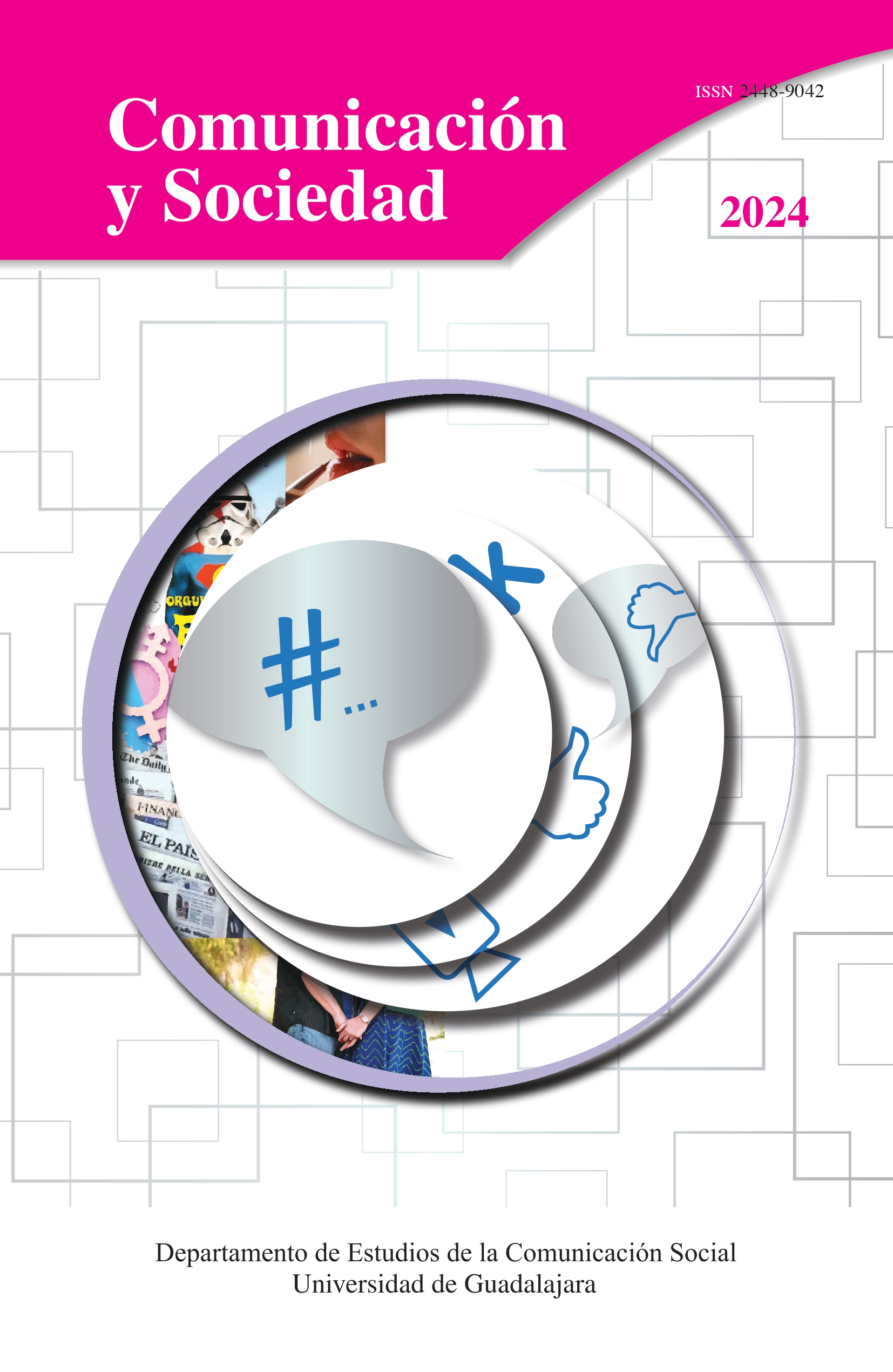Las tecnoferencias en relaciones de pareja y el género: hallazgos cualitativos
DOI:
https://doi.org/10.32870/cys.v2024.8661Palabras clave:
Género, Mundo onlife, Parejas, Phubbing, TecnoferenciasResumen
Se reportan hallazgos cualitativos sobre las tecnoferencias o phubbing en relaciones de pareja heterosexuales, mostrando la multiplicidad de experiencias que generan. El análisis sitúa el fenómeno en las dinámicas del mundo onlife y destaca diferencias de género. Sobresale que las interrupciones propiciadas por el otro tienden a ser más molestas que las propias y que los varones tienden a reclamar más y a tener mayor poder de influencia en los usos ajenos. Se concluye que las tecnoferencias más toleradas o justificadas son las que tienen que ver con el trabajo remunerado y que no siempre son involuntarias o inevitables, sino que expresan agencia comunicacional.Descargas
Citas
Barassi, V. (2020). Datafied times: Surveillance capitalism, data technologies and the social construction of time in family life. New Media & Society, 22(9), 1545–1560. https://doi.org/10.1177/1461444820913573
Bröning, S. & Wartberg, L. (2022). Attached to your smartphone? A dyadic perspective on perceived partner phubbing and attachment in long-term couple relationships. Computers in Human Behavior, 126, 106996. https://doi.org/10.1016/j.chb.2021.106996
Cantó-Milà, N., Nuñez, F. & Seebach, S. (2014). Send Me a Message and I’ll Call You Back: The Late Modern Webbing of Everyday Love Life. En R. Benski & E. Fisher (Eds.), Internet and Emotions (pp. 144-158). Routledge.
Casado, E. (2014). Tramas de género en la comunicación móvil en pareja. En A. Lasén & E. Casado (Eds.), Mediaciones tecnológicas: Cuerpos, afectos y subjetividades (pp. 53-70). Universidad Complutense de Madrid.
Casado, E. & Lasén, A. (2014). What is disturbing and why not to disturb. On mobile phones, gender, and privacy within heterosexual intimacy. Mobile media & Communication, 2(3), 249-264
Chotpitayasunondh, V. & Douglas, K. (2018). The effects of “phubbing” on social interaction. Journal of Applied Social Psychology, 48(6), 304-316. https://doi.org/doi:10.1111/jasp.12506
Cornella, A. (2008). Principio de la infoxicación. En J.J. Fernández García (Ed.), Más allá de Google (pp. 19-22). Infonomía.
Duran, R. L., Kelly, L. & Rotaru, T. (2011). Mobile phones in romantic relationships and the dialectic of autonomy vs. connection. Communication Quarterly, 59(1), 19-36. http://dx.doi.org/10.1080/01463373.2011.541336
Ekimchik, O. A. & Kryukova, T. L. (2022). Measuring Phubbing in Close Relationships: E. Karadağ`s Phubbing Scale and J. Roberts’ Scale of Partner Phubbing. Counseling Psychology and Psychotherapy, 30(3), 112-128. https://doi.org/10.17759/cpp.2022300307
Floridi, L. (2015). The online manifesto. Being human in a hyperconnected era. Springer open.
Gómez Cruz, E. (2022). Tecnologías vitales. Pensar las culturas digitales desde Latinoamérica. Universidad Panamericana, Puerta abierta editores.
Karadağ, E., Tosuntaş, Ş. B., Erzen, E., Duru, P., Bostan, N., Şahin, B. M., Çulha, I. & Babadağ, B. (2015). Determinants of phubbing, which is the sum of many virtual addictions: A structural equation model. Journal of Behavioral Addictions, 4(2), 60–74. https://doi.org/10.1556/2006.4.2015.005
Leccardi, C. (1996). Rethinking Social Time: Feminist Perspectives. Time & Society, 5(2), 169-186. https://doi.org/10.1177/0961463X96005002003
McDaniel, B. T. & Coyne, S. M. (2016). “Technoference”: The interference of technology in couple relationships and implications for women’s personal and relational well-being. Psychology of Popular Media Culture, 5, 85-98. https://doi.org/10.1037/ppm0000065
McDaniel, B. T. & Drouin, M. (2019). Daily Technology Interruptions and Emotional and Relational Well-Being. Computers in Human Behavior, 99, 1-8. https://doi.org/10.1016/j.chb.2019.04.027
McDaniel, B., Galovan, A. & Drouin, M. (2020). Daily technoference, technology use during couple leisure time, and relationship quality. Media Psychology, 24(5). 637-665. https://doi.org/10.1080/15213269.2020.1783561
McDaniel, B. T. & Wesselmann, E. (2021). «You phubbed me for that?» Reason given for phubbing and perceptions of interactional quality and exclusion. Human Behavior & Emerging Technologies, 3(3), 413-422. https://doi.org/10.1002/hbe2.255
Miles, M. & Huberman, M. (1994). Qualitative data analysis (2da ed.). sage.
Nina-Estrella, R. (2022). Phubbing: nuevas prácticas del uso del celular en el contexto de pareja. M.A. González Pérez (Coord.), Vida Digital: Efectos Sociales (pp. 1-16). fes Iztacala-unam.
Nina-Estrella, R., Montero-López Lena, M. & Manríquez Betanzos, J. C. (2020). Phubbing, comunicación tecnológica y calidad de la relación de pareja. Revista Iberoamericana de Psicología, 13(3), 37–48. https://doi.org/10.33881/2027-1786.rip.13303
Roberts, J. A. & David, M. E. (2016). My life has become a major distraction from my cellphone: Partner phubbing and relationship satisfaction among romantic partners. Computers in Human Behavior, 54, 134–141. https://doi.org/10.1016/j.chb.2015.07.058
Rodríguez, T. (2019). Internet en las relaciones de pareja establecidas: Un panorama desde la investigación internacional. En A. J. Cuevas (Ed.), Intimidad y relaciones de pareja: Exploraciones de un campo de investigación (pp. 293-329). Juan Pablos Editores, Universidad de Guadalajara.
Rodríguez, T. (2022). Los celos y las infidelidades: Tecnologías, emociones y poder (1era ed.). Universidad de Guadalajara.
Rodríguez, T. (2023). Las vivencias del tiempo durante la pandemia por el coronavirus y el uso de tecnologías digitales en la relación de pareja. E. Rodrigues & L. Castañeda (Eds.), Tiempo, poder y sociedad (43-65). Universidade do Minho, Universidad de Guadalajara.
Rodríguez, T. & Rodríguez, Z. (2020). Intimidad y relaciones de pareja durante la pandemia de la covid-19 en Guadalajara. Espiral. Estudios sobre Estado y Sociedad, 27(78-79), 215-264. https://doi.org/10.32870/eees.v28i78-79.7206
Rodríguez, Z. (2022). Sexualidad, sentimientos y emociones: un análisis generacional. Universidad de Guadalajara
Serrano-Puche. J. (2016). Internet y emociones: nuevas tendencias en un campo de investigación emergente. Comunicar, 24(46), 19-26.
Schneider, F. M. & Hitzfeld, S. (2021). I Ought to Put Down That Phone but I Phub Nevertheless: Examining the Predictors of Phubbing Behavior. Social Science Computer Review, 39(6), 1075-1088. https://doi.org/10.1177/0894439319882365
Sharma, S. (2016). Speed traps and the temporal. En The Sociology of Speed (pp. 131–151). Oxford University Press, https://doi.org/10.1093/acprof:oso/9780198782858.003.0010
Turkle, S. (2012). Alone together: Why we expect more from technology and less from each other? Basic Books.
Utami, M., Anam, M. K. & Noorrizki, R. D. (2020). The Relationship Between Phubbing and Romantic Relationship Satisfaction: A Literature Review. KnE Social Sciences, 370-385. https://doi.org/10.18502/kss.v4i15.8226
Vaterlaus, J. M. & Tulane, S. (2019). The Perceived Influence of Interactive Technology on Marital Relationships. Contemporary Family Therapy, 41(3), 247-257. https://doi.org/10.1007/s10591-019-09494-w
Descargas
Publicado
Cómo citar
Número
Sección
Licencia

Esta obra está bajo una licencia internacional Creative Commons Atribución-NoComercial 4.0.
Los autores/as que publiquen en esta revista aceptan las siguientes condiciones:
De acuerdo con la legislación de derechos de autor, los autores conservan los derechos de autoría y otorgan a Comunicación y Sociedad el derecho de primera comunicación pública de la obra. Comunicación y Sociedad no realiza cargos a los autores por enviar y procesar artículos para su publicación.
Los autores/as pueden realizar otros acuerdos contractuales independientes y adicionales para la distribución no exclusiva de la versión del artículo publicado en Comunicación y Sociedad (por ejemplo incluirlo en un repositorio institucional o publicarlo en un libro) siempre que indiquen claramente que el trabajo se publicó por primera vez en Comunicación y Sociedad.











